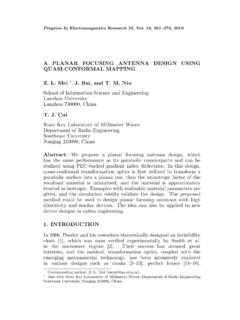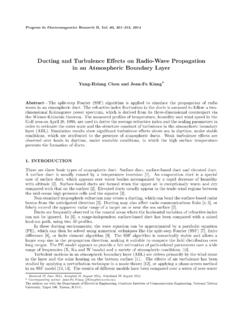Transcription of AXIAL-FLUX PERMANENT-MAGNET MOTOR DESIGN FOR …
1 Progress In Electromagnetics Research, Vol. 122, 467 496, 2012. AXIAL-FLUX PERMANENT-MAGNET MOTOR DESIGN . FOR ELECTRIC VEHICLE DIRECT DRIVE USING. sizing EQUATION AND FINITE ELEMENT ANALYSIS. A. Mahmoudi* , N. A. Rahim, and H. W. Ping UMPEDAC, Engineering Tower, University of Malaya, Kuala Lumpur, Malaysia Abstract The DESIGN process of a double-sided slotted TORUS axial- flux PERMANENT-MAGNET (AFPM) MOTOR suitable for direct drive of electric vehicle (EV) is presented. It used sizing equation and Finite Element Analysis (FEA). AFPM MOTOR is a high-torque-density MOTOR easily mounted compactly onto a vehicle wheel, fitting the wheel rim perfectly. A preliminary DESIGN is a double-sided slotted AFPM.
2 MOTOR with 6 rotor poles for high torque-density and stable rotation. In determining the DESIGN requirements, a simple vehicle-dynamics model that evaluates vehicle performance through the typical cruising trip of an automobile was considered. To obtain, with the highest possible torque, the initial DESIGN parameters of the MOTOR , AFPM's fundamental theory and sizing equation were applied. Vector Field Opera-3D commercial software ran the FEA of the MOTOR DESIGN , evaluating and enhancing accuracy of the DESIGN parameters. Results of the FEA simulation were compared with those obtained from the sizing equation; at no-load condition, the flux density at every part of the MOTOR agreed.
3 The MOTOR 's DESIGN meets all the requirements and limits of EV, and fits the shape and size of a classical-vehicle wheel rim. The DESIGN process is comprehensive and can be used for an arbitrary EV with an arbitrary cruising scenario. 1. INTRODUCTION. Protection of natural environments sparked interest in electric vehicle (EV), a non-polluting personal transport. EV first appeared in 1870. but was for many years not further past 10 years, however, have seen developmental progress of EV [1]. Battery, electric Received 4 September 2011, Accepted 22 November 2011, Scheduled 8 December 2011. * Corresponding author: Amin Mahmoudi 468 Mahmoudi, Rahim, and Ping MOTOR , MOTOR drive circuit, and transmission gears make up EV's power system.
4 Researchers and designers look into increasing the efficiency and reliability of EV power systems. Improvement of each subsystem increases the overall efficiency, and consequently, the driving range. One reason for EV's little commercial success over the past century is that its efficiency had yet to reach the public's expectations for it [2]. Low price and simple but strong physical structure are the reasons for induction MOTOR 's wide application in EV [3]. Also, it can withstand high overloading and have low torque ripple. Its disadvantages, however, are low power-density, huge size and average efficiency. PERMANENT-MAGNET MOTOR competing with induction MOTOR in EV application has recently been developed; it fulfills the required high efficiency, small size, and high power density [4 7].
5 A MOTOR designed for EV can be classified as direct drive or indirect drive [8, 9]. Direct drive excludes transmission gears and mechanical differential including the associated energy MOTOR is mounted inside vehicle wheel rim and turns the wheel directly, so it must be compact and have high torque [10]. PERMANENT-MAGNET machines generally can be AXIAL-FLUX or radial- flux [11]. Advantages of AXIAL-FLUX PERMANENT-MAGNET (AFPM) motors over conventional radial-flux PERMANENT-MAGNET (RFPM) motors include high torque-to-weight ratio, good efficiency, adjustable air-gap, balanced rotor-stator attractive forces, and better heat-removal [12 . 14]. They can be easily and compactly mounted onto vehicle wheel, fitting the wheel rim perfectly, suitable for direct drive applications.
6 AFPM machines can be single-sided or double-sided, with or without armature slots, with or without armature core, with internal or external PERMANENT-MAGNET rotors, with surface-mounted or interior PERMANENT-MAGNET , and single-stage or multistage machines [15]. Double-sided configurations have either external stator or external rotor. An external stator means fewer permanent magnets but poor use of winding, whereas an external rotor is considered particularly advantageous to machine topology. Topologies for double-sided AFPM. machines are one-stator-two-rotor (TORUS) and two-stator-one-rotor (AFIR) [16]. Among various configurations, slotted TORUS AFPM. is the most applicable [17]; double-sided slotted TORUS AFPM.
7 Configuration thus is the subject of this paper, as is its DESIGN for EV. application. Huang et al. derived the general- sizing and power-density equations for RFP machines, also a systematic method for comparing the capabilities of machines of various topologies [18]. In 1999, they developed the sizing equation for AFPM machines [19]. Aydin et al. presented optimum-sized AFPM machines for TORUS and Progress In Electromagnetics Research, Vol. 122, 2012 469. AFIR topologies [20, 21]. Since then, there have been only a few papers reporting application of sizing equation to AFPM machine DESIGN , no doubt because of its limits ( , magnet skewing and winding configurations cannot be considered) [22].
8 Unlike traditional RFPM machines, AFPM machines have a unique construction, including a complex magnetic circuit that usually needs 3D Finite Element Analysis (FEA) for DESIGN of the machines. FEA, though accurate, has a long computation time that still can increase with the remodeling (including re-meshing) required when machine geometry changes. A solution to this problem is the application of 3D FEA. complementarily to sizing equation. The electromagnetic torque against diameter ratio is extracted from AFPM machine's fundamental equation, to obtain maximum torque. A sizing equation capable of calculating,with acceptable accuracy and speed, flux distribution and torque characteristics, is then applied to obtain the initial AFPM MOTOR dimensions, before FEA is applied, for permanent- magnet skewing, accuracy enhancing, and the desired electric MOTOR parameters.
9 This research aims for an electric MOTOR that is suitable for electric vehicle application. The limits of the sizing equation used in the DESIGN was overcome by FEA, which increased accuracy, so the resulting MOTOR has high power density, a most-sinusoidal back-EMF waveform, and reduced torque. The paper is organized as follows: Section 2 presents the basic equations for vehicle dynamics; Section 3 extracts the sizing equations that give the TORUS AFPM machine its power-producing potential;. Section 4 presents the electromagnetic field analysis via FEA on the proposed MOTOR topology, from the sizing equation, for the desired parameters, results of the FEA simulation results and of the sizing equation compared; Section 5 concludes with discussing the results.
10 2. VEHICLE DYNAMIC, DESIGN RESTRICTIONS AND. REQUIREMENTS. A simple model of vehicle dynamics that evaluates vehicle performance is herewith presented. A simplified vehicle driving resistance force or road load (Frm ) consists of rolling resistance force (fro ), climbing resistance force (fst ), and aerodynamic drag force (fl ): Frm = fro + fst + fl (1). Rolling resistance force (fro ) is caused by on-road tire deformation: fro = fr M ag (2). 470 Mahmoudi, Rahim, and Ping where fr , M , and ag are rolling resistance coefficient, vehicle mass, and gravity acceleration, respectively. Climbing resistance (fst with positive operational sign) and downward force (fst with negative operational sign) are given by: fst = M ag sin (3).




